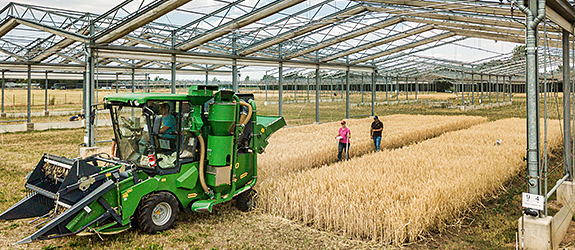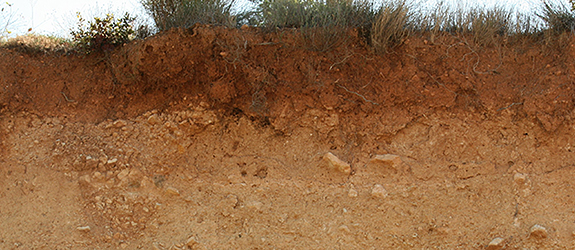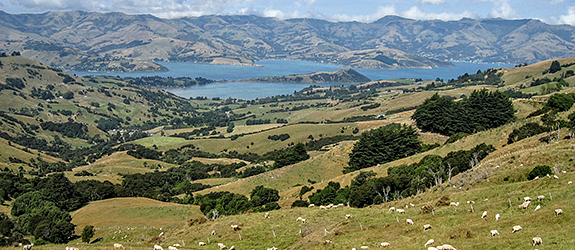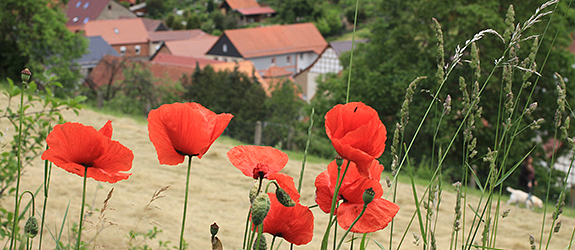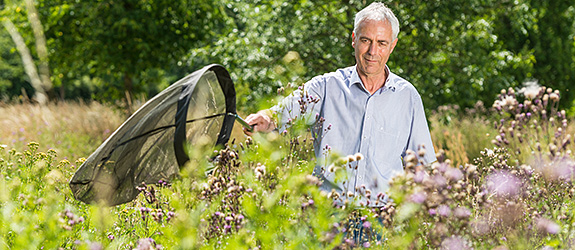Sustainable future land use
Provisioning natural resources, biodiversity and ecosystem services
Ecosystems provide the foundation of life and support our human wellbeing. Humanity depends on functioning ecosystems while human activities also form the biggest threat to ecosystems, manifested in the loss of biodiversity, decreased food supply and soil degradation. The mission of our Integration Platform "Sustainable Future Land Use" is to provide the solutions urgently needed to make ecosystems of the future stable and resilient to Global Change.
Intact functioning ecosystems provide us with an array of free services, such as high and stable yields, healthy and nutritious food, medicinal products, building materials, clean air and water, flood defence, recreational and aesthetic values. The value of these services is estimated to cover billions of Euros and costs rise with decreasing functions that we get for free, so far. All these services rely on stable and resilient ecosystem function providing fertile soils, carbon sequestration, pollination and natural pest control and many more which is provided by various aspects of biodiversity. Halting the decline in biodiversity is of utmost importance if we are to benefit from the provision of these services.
Additionally, land is a limited resource on our planet which can basically only be assigned to one specific use. Whether this is for urban development and infrastructure, agriculture and forestry, mining and industry or nature conservation, every decision made in favour or against land-use change can result in unforeseeable changes, conflicts, opportunities or new development potential.
Our research aims to understand how processes in ecosystems work and how they are connected. Strategies and instruments that ensure the resilience of ecosystems in times of global change and the services they deliver. Measures mitigating increasing pressure will be developed. Preserving and restoring biodiversity and the essential above and belowground functions of ecosystems is the key for sustainable land use.
The Integration Platform "Sustainable Future Land Use" aim to comprehensively provide the answers to the problems stated. To this end, the scientists at this Integration Platform work together in interdisciplinary Dynamic Platform Projects (DPP).
DPPs 2025
| Main PI: | Elina Takola |
| Participants: | Johanna Esguerra, Mark Frenzel, Volker Grimm, Annegret Grimm-Seyfarth |
| Participating Departments: | Computational Landscape Ecology, Community Ecology, Conservation Biology & Social-Ecological Systems, Ecological Modelling |
| Abstract: | The northern lapwing (Vanellus vanellus, DE: Kiebitz) is a bird species that breeds and feeds in open habitats such as grasslands, croplands and open flooded areas. In 2024, it was declared “Species of the year” after a public vote, organized by NABU, due to its importance for conservation and ecosystems. Although it is a common species, its population size has decreased significantly over the last decades. It is, therefore, important to understand the drivers behind the population declines. Our plan is to use real movement (GPS tracking) data to model the relationship between bird movement and landscape structure. |
| Website |
| Main PI: | Elsa Maria Cardona Santos Yves Zinngrebe |
| Participants: | Augustin Berghöfer, Hannah Korinth, Christian Kuhlicke, Guy Pe’er, Fabian Pröbstl, Johannes Schiller, Sophia Schmid, Matthias Scholz, Christoph Schröter-Schlaak, Josef Settele, Ulrike Troeger, Michael Vieweg, Heidi Wittmer |
| Participating Departments: | Conservation Biology & Social-Ecological Systems, Biodiversity & People, Economics, Environmental Politics, Urban and Environmental Sociology |
| Abstract: | Restoration and conservation efforts are crucial components of transformative change for a fair and sustainable world; however, they must be complemented by actions that address governance, economic systems, as well as transformation at the personal level. Learning from specific case studies is key to identify, contrast, and understand which barriers and transformative actions are most relevant for driving effective restoration. This synthesis project will contribute to the operationalization of the theoretical framework presented in the IPBES transformative change assessment for ecosystem restoration and governance. We propose to develop an expert synthesis process on transformative change for ecosystem restoration processes. We at UFZ are combining strong knowledge on restoration (particularly in IP1) with knowledge on social processes and governance on transformative change (IP1 and IP6). The intention is to synthesise our lessons learned and produce a perspective paper to highlight our work and expertise on restoration. |
| Main PI: | Evgenia Blagodatskaya Shang Wang |
| Participants: | Sara König, Steffen Schlüter, Mika Tarkka, Hans-Jörg Vogel |
| Participating Departments: | Soil Ecology, Soil System Science |
| Abstract: | The sensitivity of biodiversity and ecosystem functions to climate and land-use changes needs to be estimated by the set of eco-indicators linking physical and biochemical properties of the soil matrix with microbial functional traits and C transformation processes. A comprehensive soil property dataset will be generated by comparing data from GCEF, Static Fertilization Experiment, SPP Rhizosphere, and Fallow experiments, along with other ongoing experiments in Bad Lauchstädt, all sampled at the same time this autumn 2025. The sensitivity of eco-indicators will be evaluated across different experimental treatments within the same geographical site. These eco-indicators will be compared with results from previous years to assess their sensitivity to annual variations, particularly climate effects. |
| Main PI: | Hanna Honchar |
| Participants: | : Christophe Dominik, Murray Hamilton, Lucie Moeller, Oliver Schweiger, Ralf Trabitzsch, Simon Wogram |
| Participating Departments: | Community Ecology, Environmental Informatics, Systemic Environmental Biotechnology |
| Abstract: | Green roofs are often suggested as a nature-based solution to help mitigate the adverse effects of urbanization by increasing green space in urban areas. These artificial structures can also serve as habitat for certain insects and moreover be a source of nectar and pollen for pollinators. In the light of the global decline in pollinators, green roofs are being integrated into initiatives promoting pollinator-friendly practices in urban conservation efforts, aligning with the urban pollinator strategy outlined by the EU Commission’s guidance for creating pollinator-friendly cities. While the diversity of pollinators on green roofs is well documented, limited information exists on intra- and interspecific interactions, particularly in response to the restricted floral resources green roofs provide. We aim to assess temporal dynamics of insect pollinator communities and their intra- and interspecific interactions using a novel automated monitoring system. In addition, we seek to validate a cost-effective system that can be easily replicated (e.g. by citizen scientists) using readily available tools. |
| Main PI: | Guy Pe’er Julian Rode |
| Participants: | Elizabeth Finch, Roel van Klink, Judith Rakowski, Linn Schaan, Daniel Vedder |
| Participating Departments: | Biodiversity & People, Environmental Politics |
| Abstract: | Scholars warn that multiple concurring crises are coalescing into one global polycrisis. The term "polycrisis" has hence gained prominence, capturing the interconnected nature of global challenges such as climate change, pandemics, social conflicts, and economic instability. Understanding and addressing this polycrisis requires a systematic analysis of its components, their interlinkages, ultimate drivers, and potential solutions. We will map the direct and indirect linkages of different global crises and their drivers. Our aim is to analyze different interventions and solutions to address the polycrisis. |
| Main PI: | Steffen Schlüter |
| Participants: | Evgenia Blagodatskaya, Max Köhne, Ines Merbach, Thomas Reitz, Martin Schädler, Hans-Jörg Vogel, Ulrich Weller |
| Participating Departments: | Soil System Science, Community Ecology, Soil Ecology |
| Abstract: | Alfalfa is a perennial forage crop with a deep taproot system and natural nitrogen fixation by root nodules. Integrating alfalfa into crop rotation has several benefits for soil functioning regarding nutrient cycling, deep water cycling, and soil structure improvement. An 8-year crop rotation with 2-year alfalfa was established at the static fertilization experiment in 1926 on stripe (Schlaghälfte) 8. Alfalfa will be planted in spring 2025 and cultivated for two years. By sampling selected alfalfa plots in spring 2025 and spring 2027 and comparing them to adjacent plots without alfalfa in the crop rotation (stripe 6), it will be possible to estimate long-lasting legacy effects and immediate effects, respectively. While alfalfa effects in soil properties are well-known for topsoils, their effect on deep soils is understudied due to the difficult, laborious sampling. By digging 2m deep soil pits on site in spring 2025 (but not 2027) through the EU-funded DeepHorizon project, we have the unique opportunity to do complimentary sampling for many different analyses of deep soil that has never been sampled before, but is thought to have an important function as habitat, nutrient and water reservoir. The aim of this DPP is to investigate how alfalfa cultivation induces immediate and/or long-lasting legacy effects on soil structure, chemical properties, microbial activity and diversity, faunal abundance, and soil hydraulic properties. |
| Main PI: | Rosario Iacono |
| Participants: | Marie-Lara Bouffaud, Sara König |
| Participating Departments: | Soil Ecology, Soil System Science |
| Abstract: |
Vertical farming presents a promising solution for future food security and ecosystem restoration through land sparing. However, this approach faces challenges related to reduced plant-microbe interactions. It is well established that a diverse and functional microbiome is critical for crop growth, nutrient uptake, disease resistance, and fruit quality in plants like tomatoes. The absence of such microbial communities leads to reduced biomass, altered flavour profiles, and decreased resilience to environmental stresses, underscoring their importance in sustainable agriculture and crop productivity. Despite these insights, significant knowledge gaps remain in the context of vertical farming systems. Specifically, the impact of varietal differences and the absence of association with arbuscular mycorrhizal fungi (AMF) are not well understood. Addressing these gaps is crucial for optimizing plant health, productivity, and resource efficiency in controlled environments. This project aims to explore two key aspects: • The varietal effect on growth, resilience, and yield in vertical farming systems. • The consequences of AMF absence on plant development and potential interactions between genotype and symbiont communities. By investigating these factors, we can better adapt crop varieties to vertical farming conditions and develop strategies to mitigate the challenges posed by limited microbial diversity in these systems. |
| Main PI: | Taimur Khan |
| Participants: | Ulf Mallast |
| Participating Departments: | Community Ecology, Monitoring and Exploration Technologies |
| Abstract: | Most deep learning-based tree crown segmentation models rely on datasets collected at random points in time or a single snapshot, limiting their ability to generalize across seasons and changing environmental conditions. Tree crowns exhibit dynamic seasonal changes, including leaf emergence, peak greenness, senescence, and dormancy, but current AI models fail to explicitly encode these phenological cycles. This results in segmentation models that misclassify phenological variations as structural differences, reducing their robustness in monitoring forest ecosystems over time. PhenoEmbed addresses this by combining high-resolution, multi-temporal UAV-based multispectral imagery with phenological embeddings, allowing AI models to move beyond static segmentation and learn temporally informed tree crown representations. Phenological embeddings act as a bridge between spatial features and seasonal dynamics, enabling AI models to distinguish between intra-annual changes and long-term ecosystem shifts. This benchmark dataset is designed to advance AI-driven phenology monitoring, tree crown segmentation, and ecosystem state modelling, facilitating a new standard for time-aware deep learning applications in forest ecology and beyond. |
Impact of land-use change on the assembly of soil microbiome along soil depth – DeepSoil-MicroBiomes
| Main PI: | Tesfaye Wubet |
| Participants: | Abebaw Ambaw, Lara Krunes, Steffen Schlüter, Doris Vetterlein |
| Participating Departments: | Community Ecology, Soil System Science |
| Abstract: | Soil microbiomes are critical to ecosystem functioning and soil health. However, land-use changes might result in perturbation of the soil biodiversity with consequences for ecosystem functions including nutrient cycling, plant nutrient uptake, carbon storage, infiltration and above ground productivity. Though conversion of croplands to grasslands could change the above ground vegetation and their rooting depth, the impact of these land-use changes on the soil pore structure and consequently to the belowground soil microbiome assemblage with increasing soil depth is yet unknown. Within the RootEd project (https://sites.google.com/view/rooted-doctoral-network/work-packages) a total of 8 soil sampling campaigns were performed from 8 study sites with a land-use change history of at least 10 years, in Germany. Soil physico-chemical and soil pore analysis as well as root analyses will be carried under the RootED project and data will be available as explanatory variable for the soil microbiome data. The soil subsamples collected for soil prokaryotic and eukaryotic microbiome analysis (8 study sites x 2 land-use types x 4 sampling plots x 4 soil depths [0-10cm, 10-20cm, 20-45cm and 45-60cm] = 256 samples) employing metabarcoding will be used in this project to generate the microbiome datasets. The aim of this DPP is to investigate the impact of land-use change on the soil microbiome assemblage along soil depth in cropland and grassland ecosystems. |
| Main PI: | Ute Wollschläger |
| Participants: | Marie-Lara Bouffaud, Sara König, Ines Merbach, Martin Schädler, Thomas Reitz, Mika Tarkka, Hans-Jörg Vogel |
| Participating Departments: | Soil System Science, Community Ecology, Soil Ecology |
| Abstract: |
The relevance of sustainable soil management in agriculture is receiving more and more attention and is closely related to several issues concerning climate change, biodiversity loss, eutrophication of surface waters and others. Several UFZ departments work on various questions of sustainable soil management including field experiments and models. Our aims are: • Raising awareness among farmers about sustainable soil management and work conducted at UFZ • Discuss about challenges in sustainable soil management measures both in general but also locally to better align our research with the needs of the farmers • Exchange about research questions that can be conducted in co-design with farmers and other stakeholders |
- Mapping soil profiles and measuring horizon properties of the Static Fertilization Experiment Bad Lauchstädt to improve agroecosystem modelling (PI: Julius Diel, BoSys)
- Digitalizing root growth data from the archives of the Static Fertilization Experiment Bad Lauchstädt (PI: Julius Diel, BoSys)
- Soil structure and biochemical properties as function of management in a long-term fallow trial (PI: Steffen Schlüter, BoSys)
- Towards in-depth characterization of soil micro-environments: eco-indicators and mechanisms driving soil C sequestration (PI: Evgenia Blagodatskaya, BOOEK)
- Root-associated microbial communities at MyDiv (PIs: Kezia Goldmann, BOOEK & Stephanie Jurburg, AME)
- Bioaccumulation of pesticides and selected legacy and emerging pollutants in amphibians in relation to agricultural and dump sites (PI: Annegret Grimm-Seyfarth, NSF)
- The role of hybridisation and genetic variation in the conservation of the rare and endangered plant species Lupinus tidestroemii (PI: Walter Durka, BZF)
- Historic composition of bee communities in Leipzig and Halle (PIs: Hanna Honchar, NSF & Tiffany Knight, SIE)
- In which cases does surrounding landscape structure affect agricultural yields? (PI: Elina Takola, CLE)
- Which agricultural management practices lead to win-win outcomes for biodiversity and yield? (PI: Elina Takola, CLE)
- DeepTrees -- Deep-Learning based spatiotemporal tree inventorying and monitoring from public orthoimages (PI: Taimur Khan, BZF)

